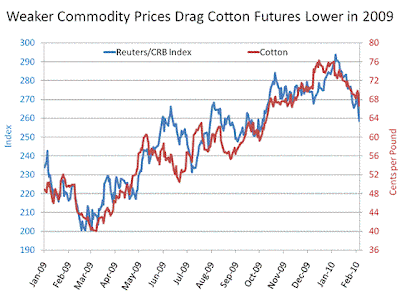
for more analysis like this, please click here.
After again largely ignoring fundamentals internal to the cotton market, cotton futures prices retreated for the fifth straight week, succumbing to the overarching bearish influence of a stronger dollar. The Nearby price on the ICE Futures U.S. exchange plunged 241 points from the previous week to 66.62 cents per pound, a two-month low. This weighed on every subsequent contract month, dragging each lower again, down for every week in 2010. While the week did produce some bullish news for cotton, the dollar remains the key drag on the market.
The bulls took little comfort in robust export sales and further evidence of a smaller Indian crop last week. Net upland sales jumped to a marketing-year high of 519,500 running bales, particularly driven by big volume to China. Weekly shipments also improved, reaching almost 250,000 bales, the second-highest point so far in 2009/10. Exports to mid-tier markets like Mexico, Thailand, and Peru also climbed to marketing-year highs, and market sentiment suggests shipments in coming days are also likely to remain strong.
More voices are adding to the cacophony of suspicion that India’s harvest size is overstated, echoing our long-held argument here. Most recently, the Cotton Association of India pegged the harvest size lower from their earlier forecasts at just 30.2 million bales (170kg), down half a million bales from their previous forecast just over two months ago. We would not be surprised to see forecasts ease even lower in coming months, heartening the bulls’ position.
In spite of these signals of tighter fundamentals last week, the dollar remains the 800-pound gorilla weighing on commodity markets, including cotton. Signs of debt troubles in several European markets are sinking the euro, driving the greenback higher and dragging commodity prices lower. After reaching a fourteen-month high earlier this year, the Reuters/CRB Index is down 35 points to 258.55, a three-month low. Cotton prices are lower in concert with the collapse in the broader index. If the lack of concrete proposals to the European debt concerns from this weekend’s G-7 meeting is any guide, the euro may remain under pressure in coming weeks, implying commodity prices—including cotton prices—also may struggle to post a sustained rebound in the near term.

Looking ahead, our estimates for changes to the forthcoming USDA WASDE forecasts portend tighter domestic markets for the current marketing year:
-U.S. production for 2009/2010: We see the USDA easing its production forecast for the fourth time in five months, down to 12.25 million bales. The volume of ginning and classing of this season's crop here and here remains behind this point last year, hinting that the anticipated harvest size will contract further. In fact, we would not be surprised to see the final crop size even lower—closer to 12.1 million—but we look for the USDA to make only another incremental step in that direction in its February report.
-U.S. exports for 2009/2010: We look for the USDA to revise its export forecast higher again in February, to 11.15 million bales. Already, this moving target has been revised 800,000 bales higher over the last five months, and particularly in light of robust export reports in recent weeks, we anticipate the actual level to be higher than the current 11.0 million-bale forecast.
-Ending stocks for 2009/2010: With a 150,000-bale increase in the harvest size, a 150,000-bale increase in exports, and no presumed change in mill use, ending stocks are likely to ease by 300,000 bales from January's 4.3 million bales to 4.0 million. If so, this would mark the fifth straight month of gradually lower ending stocks. Coupled with higher demand, the lower ending stocks imply a tighter anticipated stocks-to-use ratio for 2009/10, friendly to higher prices. As a result, we look for the market to grapple in coming weeks with the opposing prospects of tighter ending stocks in 2009/10 versus the heavy influence of a stronger dollar.
No comments:
Post a Comment